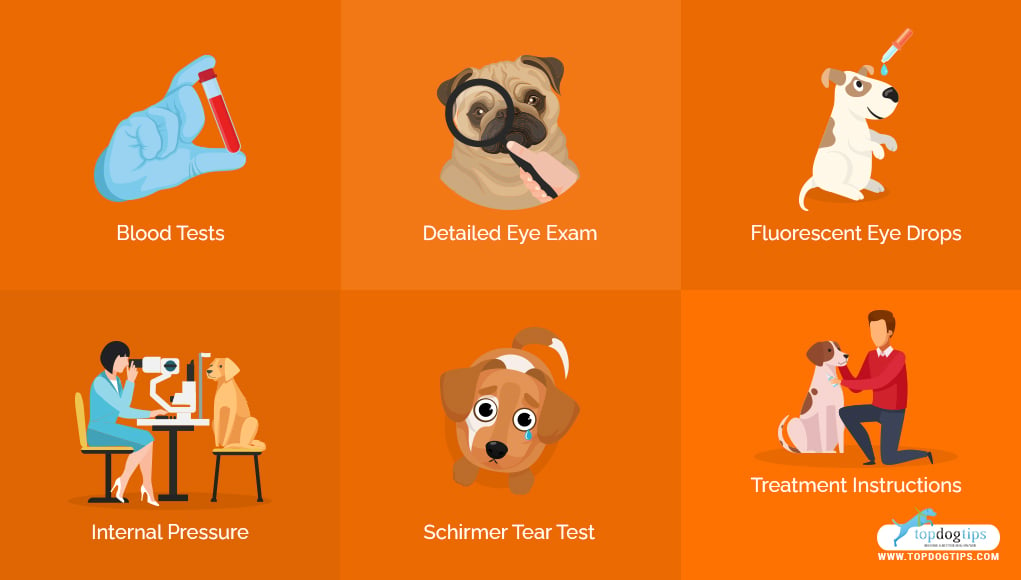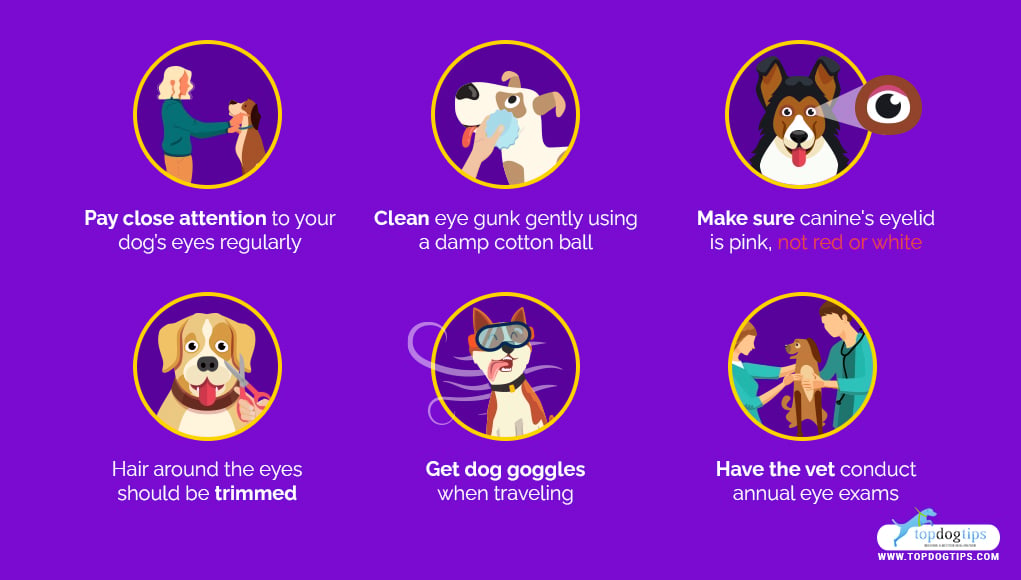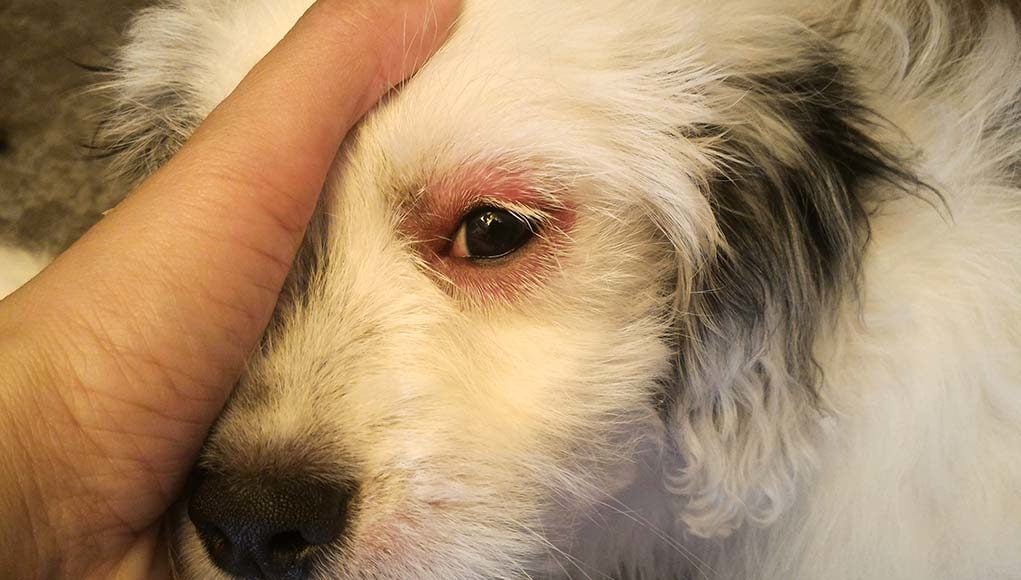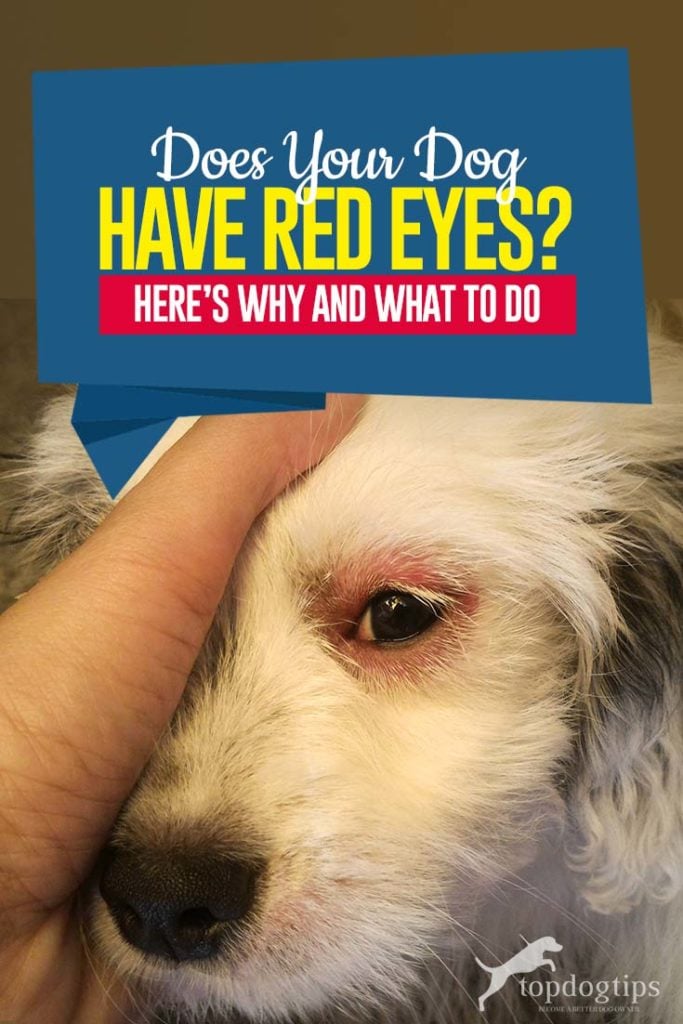Table of Contents
- Causes of Red Eyes in Your Dog
- Diagnosis of Red Eyes in Your Dog
- How to Keep Your Dog’s Eyes Healthy
- Common Questions about a Dog's Eyes' Red Color
- What Does It Mean When a Dog's Eyes Are Red?
- How Do You Treat Red Eyes in Dogs?
- How Can I Treat My Dog's Red Eye at Home?
- How Can I Treat My Dog's Eye Infection without Going to the Vet?
- How Do You Treat Cherry Eye in Dogs?
- Does Cherry Eye Hurt a Dog?
- Why Is My Dog's Eye Red and Cloudy?
- Why Are My Dog's Eyes Red and Watery?
Most days, you look into your dog’s soulful eyes and wonder what your friend is thinking. There is no question that much of your pup’s expressiveness lies there.
But one day, you look into them, and you see red eyes in your dog.
A dog’s eyes are much like human ones: they look bright and clear when they're healthy.
When something is wrong, your pet’s eyes may look pink or ruddy, which are usually signs of irritation. This isn’t comfortable for your pooch.
So now you're asking yourself, my dog has red eyes, what's going on? Here's what it could be.
Causes of Red Eyes in Your Dog
Several culprits could result in red eyes in dogs.
1. Allergy
Your dog may experience seasonal allergies, which result in red eyes caused by the environment or, in some cases, brought on by diet.
The best way to tackle this is by tracking when a dog has a red-eye outbreak.
If it's only during a specific part of the year, then simple dog eye drops like Nutri-Vet will help relieve eye redness in your dog.
If it’s a year-long or a food-related allergic reaction, it will take longer to figure out the culprit, and you will need to discuss this with a vet.
2. Cherry Eye
If you see a bulge of pink, usually near the corner of the eye closest to the dog’s nose, this is likely a condition called Cherry Eye.
Dogs have a third eyelid that you can’t normally see. This pops out in animals who have weak ligaments holding that lid in place.
Certain breeds have a propensity toward Cherry Eye, such as:
- Beagles
- Bloodhounds
- Bulldogs
- Cocker Spaniels
- Lhasa Apsos
- Maltese
- Poodles
- Pugs
- Shih Tzus
The usual treatment for Cherry Eye in dogs is surgery on the third eyelid because the gland produces about half of your dog's tear film.
Without this, your dog can move into the dry eye, which impairs a dog’s vision over time.
Most dogs recover from Cherry Eye surgery within a few weeks.
3. Corneal Damage
Anything that damages a dog's cornea can cause red eyes due to irritation. For example, if a dog’s eye gets poked with some weed or scratched by a persnickety cat.
Corneal damage in dogs typically heals in about three days. You may have to administer antibiotic eye drops (prescribed by a veterinarian) for pain and prevent potential eye infections.
4. Dry Eyes
Dry eyes are fairly common in canines. When your dog’s eyes don’t produce enough tears to keep them moist, it also increases the chance of unwanted agents entering them.
If it's dry eyes, that's causing redness.
Your veterinarian will typically prescribe a special eye drop that not only soothes the eye and improves tear production in your pooch but also washes out any bits of debris or treat an infection.
5. Glaucoma
Glaucoma is a fluid build-up in your dog’s eye, which, over time, can lead to blindness. If this is the case, the dog’s eyes may also look swollen.
This is a severe condition that requires vet attention as soon as you notice symptoms.
6. In-Grown Eyelids (Entropion)
In the case of Entropion in dogs, your pet's eyelids roll inward and cause them discomfort. It also can result in damage.
Breeds commonly susceptible to this include:
- Akita
- American Strafford Terrier
- Basset Hound
- Bloodhound
- Bulldog
- Dalmatian
- Great Dane
- The Great Pyrenees
- Irish Setter
- Mastiff
- Old English Sheepdog
- Pomeranian
- Shar-Pei
- Spaniel
- Rottweiler
This condition requires surgical correction.
7. Pink Eye
Also known as conjunctivitis, Pink Eye in dogs occurs when the inner eyelid becomes inflamed. You see this as pinkness.
Conjunctivitis may be contagious to other pets, particularly if it is bacterial-based.
Treatments include artificial tears, steroid eye drops, and cool eye compresses when your dog is resting.
Many times your dog’s red eyes are a temporary reaction to some irritation. However, red eyes can indicate underlying medical problems like diabetes or hyperthyroidism.
Symptoms that imply something more is going on include:
- Constant eye-watering
- Discharge (yellow or green)
- Mucus discharge
- Rubbing of their eyes on furniture
- Squinting or frequent blinking
Take note of these and tell your veterinarian.

Diagnosis of Red Eyes in Your Dog
When you take your pet to the vet for red-eye symptoms, what can you expect? The exact diagnosis of red eye in dogs depends on what your vet expects, but here are a few things that happen:
Blood Tests: A blood screening can detect underlying illnesses that result in eye redness and irritation.
Detailed Eye Exam: This way, the vet knows exactly what part of your pup’s eyes is red. Your vet may track your dog’s vision and examine the structure of your dog’s eye.
Fluorescent Eye Drops: These reveal corneal scars or scratching.
Internal Pressure: A Tonometer reads the pressure of your dog’s eye to rule out Glaucoma.
Schirmer Tear Test: These measures tear production. The test consists of small strips of paper held in the dog’s lower eyelid. Your dog may fuss a bit, but it’s not painful.
During this test, your vet may collect some resulting fluid and check it for bacteria.
Treatment Instructions: Ensure your vet tech shows you how to administer any recommended medications, such as applying eye ointment or drops.
If it turns out that there is a serious cause for your dog's red eyes, you may have to go to a specialist for further examination and treatment.

How to Keep Your Dog’s Eyes Healthy
Start by paying close attention to your dog’s eyes regularly. Look for any signs of discharge or crusting.
The area around the eyeball should be white and bright. Any change in color, cloudiness or uneven pupils means a vet visit is in order.
Even the tiniest of dogs will sometimes have eye gunk or eye boogers in the corner of their eye. Clean this out gently using a damp cotton ball.
While you are there, take a look at the lining of your canine’s eyelid. It should be pink, not red or white.
If you have a long-haired dog, keep the fur away from their eyes, and ensure that area remains well-groomed. Those long hairs can scratch your dog’s eyes.
For dogs who love to travel by their head out the car window, get dog goggles. The wind can bring all types of debris with it, injuring your dog’s eyes.
Last but not least, keep your eyes on your dog’s behavior and appearance, and have your vet conduct annual eye exams.
Common Questions about a Dog's Eyes' Red Color
Still, have questions about your dog's eyes' red color? Read on to get answers to common questions about your canine companion's eyes.
What Does It Mean When a Dog's Eyes Are Red?
There are plenty of reasons you may notice red eyes in dogs. They may have severe or mild allergies, something in their eye, dry eye, conjunctivitis, glaucoma, a bacterial infection, or something else.
Other possibilities include a corneal ulcer, high blood pressure, pink eye, and problems with the blood vessels in the eye.
Take your dog to a veterinary ophthalmologist if you notice red eyes that don't go away.
How Do You Treat Red Eyes in Dogs?
The treatment for your pet's eye will depend on the problem. If there is a foreign object in his eye, your vet will start by removing it.
The proper treatment for this and other issues may include oral medications, topical medications, and surgery. Surgical removal of the eyes is not usually necessary, but it is a possibility in severe cases.
How Can I Treat My Dog's Red Eye at Home?
Start by checking the eye for a foreign object. You can also use a saline solution to try to remove a foreign body.
If you can't figure out the problem, take your dog to the vet to ensure it is not a serious eye injury.
Trying to remove a foreign body yourself could result in excessive tearing of the eye, so always be careful. You don't want to make your dog's eye injury worse accidentally.
How Can I Treat My Dog's Eye Infection without Going to the Vet?
If your dog has an eye infection, he needs the appropriate treatment. Unfortunately, only a vet can provide it.
You can use a saline rinse if you only notice minor issues like watery discharge and slight redness. Take your dog to the vet for minor to serious eye problems, including unusual eye discharge.
How Do You Treat Cherry Eye in Dogs?
If the vet suspects that your dog has cherry eye and confirms it, the condition may require surgical removal of the eyelid.
The vet may also surgically reposition the gland. Obliterating the gland could require lifelong treatment for low tear production.
Does Cherry Eye Hurt a Dog?
Cherry eye is not an emergency, but it can irritate your dog. It can lead to pain and even blindness. It can also cause infections in dogs' eyes.
Why Is My Dog's Eye Red and Cloudy?
The most common causes behind red, cloudy eyes are cataracts or nuclear sclerosis in older dogs.
Even if you think your pup has dry eye syndrome, take him to the vet. Remember that a condition left untreated can worsen and become more serious.
Remember that some breeds are prone to eye issues, such as those with long hair or flat-faced breeds.
Bring them to the vet if you have flat-faced or long-haired breeds and notice issues with your dogs' eyes.
Why Are My Dog's Eyes Red and Watery?
There are plenty of reasons your canine may have red, watery eyes. It may be food allergies, an injury, a congenital disability, conjunctivitis, something in his eye, dry eye, tumors, or distemper.
Your vet will look at other symptoms of redness to determine the issue and heal the red-eye. They will likely carefully examine the inner corner of the eye, the tear glands, and more.
They may look for corneal ulcers and other specific issues.
READ NEXT: 9 Most Common Dog Eye Problems (How to Prevent and Treat Them)
Disclosure: We may earn affiliate commissions at no cost to you from the links on this page. This did not affect our assessment of products. Read more here and find full disclosure here.















